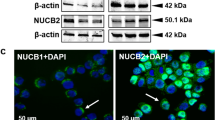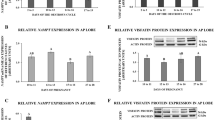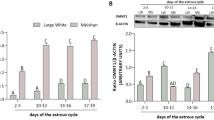Abstract
OESTROGEN, an essential physiological regulator of reproductive function1, controls lactotroph proliferation and prolactin release2. The neuropeptide galanin co-localizes to the lactotroph3, but its physiological function is largely unknown. Pituitary galanin expression is extremely sensitive to the oestrogen status of the animal. A marked elevation occurs during pregnancy and lactation4, and exogenous 17β-oestradiol can cause a 4,000-fold increase in messenger RNA levels5. Here we report that galanin is secreted by a minority of lactotrophs and is essential for the regulation of basal and vasoactive-intestinal-polypeptide-stimulated prolactin release. Hyperoestrogenization increases the number of galanin-secreting cells and the resulting increase in basal prolactin release is completely abolished by treatment with galanin anti-serum. Galanin is a potent lactotroph growth factor and galanin-immunoneutralization completely inhibits the previously reported6–8 mitogenic effects of oestrogen on the lactotroph. These findings represent direct evidence for paracrine regulation of lactotroph function and demonstrate that the effect of oestrogen on lactotroph proliferation and prolactin release are mediated by locally secreted galanin.
This is a preview of subscription content, access via your institution
Access options
Subscribe to this journal
Receive 51 print issues and online access
$199.00 per year
only $3.90 per issue
Buy this article
- Purchase on Springer Link
- Instant access to full article PDF
Prices may be subject to local taxes which are calculated during checkout
Similar content being viewed by others
References
Knobil, E. Recent Prog. Horm. Res. 36, 53–88 (1980).
Franks, S. Clin. Sci. 65, 457–462 (1983).
Steel, J. H. et al. Histochemistry. 93, 183–189 (1989).
Gabriel, S. M., Koenig, J. I. & Kaplan, L. M. Neuroendocrinology 51, 168–173 (1990).
Kaplan, L. M. et al. Proc. natn. Acad. Sci. U.S.A. 85, 7408–7412 (1988).
Inagaki, H. & Hori, T. No. To. Shinkei 41, 593–601 (1989).
Trouillas, J., Girod, C., Claustrat, B., Joly-Pharaboz, M. O. & Chevallier, P. Cancer Res. 50, 4081–4086 (1990).
Tatar, P., Knopp, J. & Jurcovicova, J. Expl clin. Endocrinol. 97, 29–33 (1991).
Morel, G., Besson, J., Rosselin, G. & Dubois, P. M. Neuroendocrinology 34, 85–89 (1982).
Vrontakis, M. E., Peden, L. M., Duckworth, M. L. & Friesen, H. G. J. Biol. Chem. 262, 16755–16758 (1987).
Rotsztejn, W. H., Dussaillant, M., Nobou, F. & Rosselin, G. Proc. natn. Acad. Sci. U.S.A. 78, 7584–7588 (1981).
Koshiyama, H. et al. Neurosci. Lett. 75, 49–54 (1987).
Melander, T., Fuxe, K., Harfstrand, A., Eneroth, P. & Hokfelt, T. Acta Physiol. scand. 131, 25–32 (1987).
Lam, K. S., Lechan, R. M., Minamitani, N., Segerson, T. P. & Reichlin, S. Endocrinology 124, 1077–1084 (1989).
Carrillo, A. J. & Phelps, C. J. Endocrinology 131, 964–969 (1992).
Reymond, M. J., Nansel, D. D., Burrows, G. H., Neaves, W. B. & Porter, J. C. Acta endocrinol. 106, 459–470 (1984).
Bauer, F. E. et al. Gastroenterology 91, 877–883 (1986).
Shimatsu, A. et al. Neurosci. Lett. 43, 259–262 (1983).
O'Halloran, D. J. et al. Endocrinology 127, 467–475 (1990).
Bjoro, T. et al. Biosci. Rep. 10, 189–199 (1990).
Bjoro, T. et al. Molec. cell. Endocrinol. 49, 119–128 (1987).
Aizawa, T. & Hinkle, P. M. Endocrinology 116, 909–919 (1985).
Denef, C. et al. Meth. Enzym. 168, 47–71 (1989).
Wynick, D. et al. Proc. natn. Acad. Sci. U.S.A. 90, 4231–4235 (1993).
Wynick, D., Critchley, R., Venetikou, M. S. Burrin, J. M. & Bloom, S. R. J. Endocrinol. 126, 269–274 (1990).
Phelps, C. & Hymer, W. C. Neuroendocrinology 37, 23–31 (1983).
Krown, K. A., Wang, Y. F., Ho, T. W. C., Kelly, P. A. & Walker, A. M. Endocrinology 131, 595–602 (1992).
Green, L. M., Reade, J. L. & Ware, C. F. J. immunol. Meth. 70, 257–268 (1984).
Kendall, M. E. & Hymer, W. C. Endocrinology 121, 2260–2262 (1987).
Author information
Authors and Affiliations
Rights and permissions
About this article
Cite this article
Wynick, D., Hammond, P., Akinsanya, K. et al. Galanin regulates basal and oestrogen-stimulated lactotroph function. Nature 364, 529–532 (1993). https://doi.org/10.1038/364529a0
Received:
Accepted:
Issue Date:
DOI: https://doi.org/10.1038/364529a0
This article is cited by
-
Chronic increase of circulating galanin levels induces obesity and marked alterations in lipid metabolism similar to metabolic syndrome
International Journal of Obesity (2009)
-
Targeted Disruption of the Galanin Gene Attenuates Inflammatory Responses in Murine Skin
Journal of Molecular Neuroscience (2008)
-
Galanin-Like Peptides Exert Potent Vasoactive Functions In Vivo
Journal of Investigative Dermatology (2007)
-
Key stages in mammary gland development - The alveolar switch: coordinating the proliferative cues and cell fate decisions that drive the formation of lobuloalveoli from ductal epithelium
Breast Cancer Research (2006)
-
Galanin and galanin receptors in human gliomas
Acta Neuropathologica (2003)
Comments
By submitting a comment you agree to abide by our Terms and Community Guidelines. If you find something abusive or that does not comply with our terms or guidelines please flag it as inappropriate.



